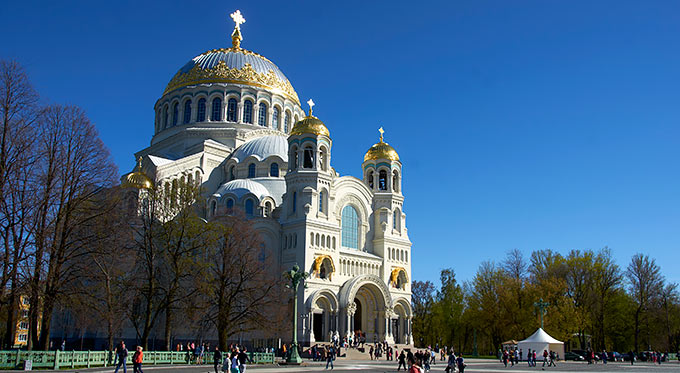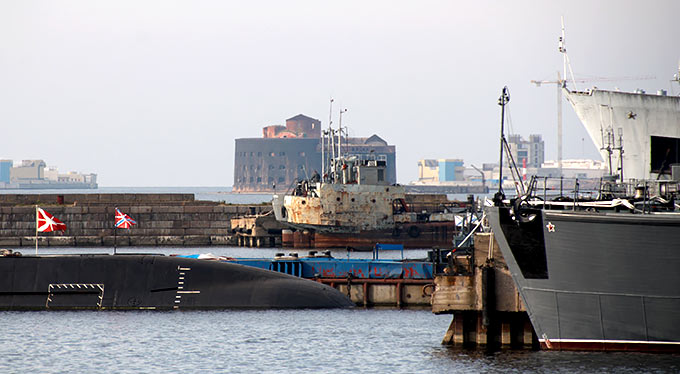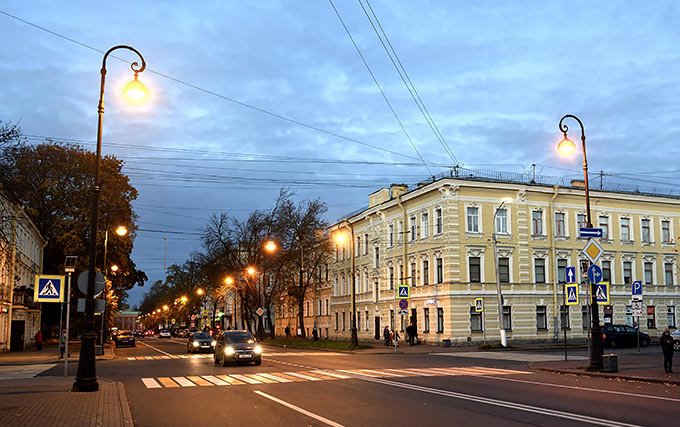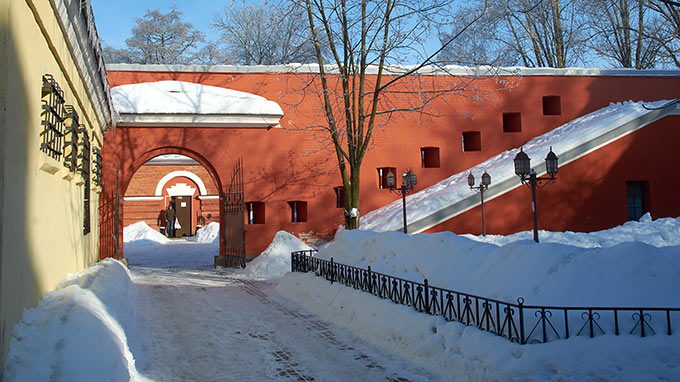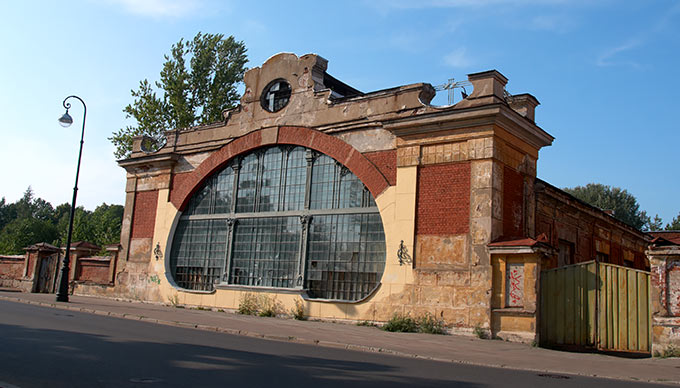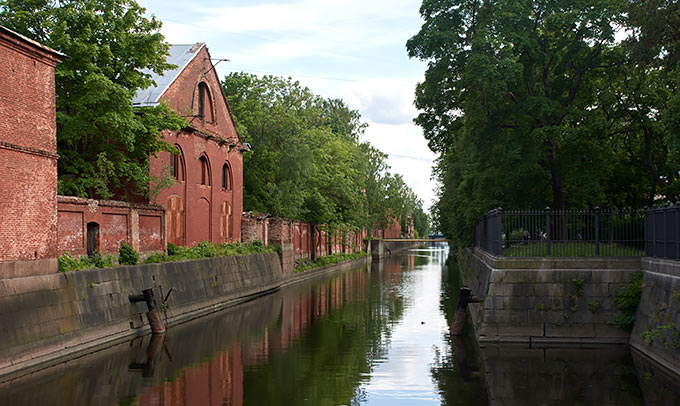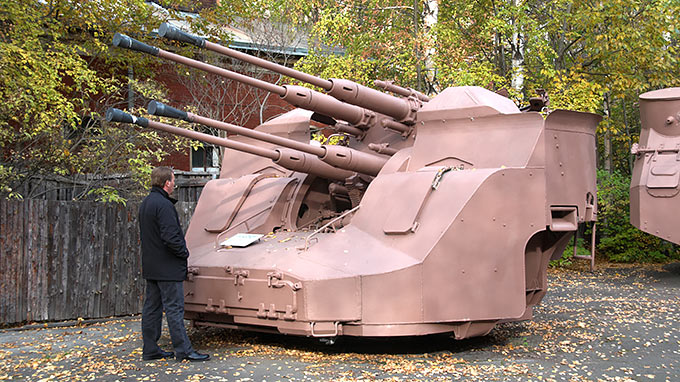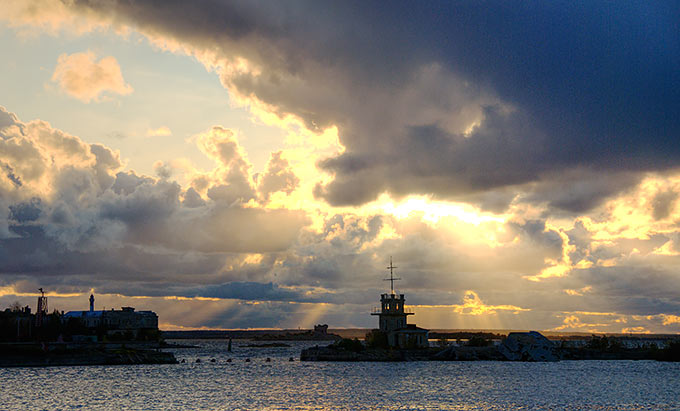Kronstadt town and Kotlin island
The history island of Kotlin (Rutusaari, Ryszard) where Kronstadt is generally wellknown to every educated Russian, so I'll limit myself by a brief enumeration of facts and dates, without going too much into the Kronstadt's history jungle.
'1703 in the month of May, of blessed memory of Emperor Peter the Great laid ... at the mouth of the Neva River on the good island of Lust-Elant the Fortress of St. Petersburg.' Autumn of the same year, naval fortress of Kronschloss (Kronshlot) was begin and was finished and armed with artillery early May next 1704 year. From this time history Kronstadt fortress began. Here we will treat about fortifications on the island of Kotlin, relating to the actual town of Kronstadt and limited not a big size of it.
After Poltava battle, in 1709, Peter 'being lost under the belly' (threat of the death penalty) ordered to build a harbor and warehouses on the island against new built fort Kronschloss and for this significant number of Swedish prisoners of war and Russian serf peasants were got to the island for the gathering stones. In 1712 under the constant vigil of the tzar himself big construction was started. Chief manager of the harbor's construction was Englishman on the Russian service Edward Leyn.
In 1712 construction of so called 'Gubernsky' (provincial) brick houses was begun, money and workers for whom each Russian provinces should provide. First brick factory was found in this time. The works involved well known Italian architect Domenico Trezini. All brick building in Russia beside St .Petersburg and Kotlin island was prohibited by tzar.
In 1718 the construction of the Kupecheskaya (Merchant) harbor was completed generally by installation at malls around it more than 100 guns. Kronstadt turned into a 'Russian Dardanelles.'
By the way, back in 1707 in Kronstadt footstock service to measure a sea level was established, common throughout all the Russian empire territory.
In 1791 Peter the Great ordered to begin the construction of naval dock. Hundreds of soldiers and peasants were digging huge canal in the swampy soil. In order to make a free room for the construction more than a hundred houses and huts inhabitants and garrison officers were demolished. Peter the Great dreamed to turn Kronstadt into the New Amsterdam and designed to cover all the island with network of canals. In 1720 Srednaya (Middle) and Voennaya (Military) harbors were finished.
October 7 th, 1723 so called Citadel or city fortifications were founded and the city and the fortress got their essential name Kronstadt, and there was a strict tzar's order to call them so and nothing else (besides 'being lost under the belly'). The tzar himself has marked a new bastions in the western part of the fortress.
In 1724 there was two quite big floods and all new construction works were stopped a couple of years completely. Citadel fortifications with it's bastions and batteries were completed in 1729.
In 1752, engineer von Lyuberas finally finished building of Petrovsky dock with dock pool, on which in 1777 first in Russia industrial steam engine for pump water out the pool was installed. That steam engine was imported from England.
In 1781 with the initiative of Admiral Greig and under the menage of engineer Bour lining with stone of walls of Kronstadt harbors was started.
In 1783, there was a big fire of Admiralty in St. Petersburg and pretty scared of that Catherine II ordered to transfer Admiralty to the dogs away from the Winter Palace far to Kronstadt. All the Admiralty authorities and other officials were exceedingly 'pleased' of the decree. Construction of the New Admiralty project of adm. Greig began in 1785. Admiralty consists of a vast complex of warehouses, factories and workshops, surrounded by a deep channel. Again it had to endure a couple of hundred houses were demolished, to make a way for new construction. However, St. Petersburg Admiralty officials have not moved to 'Sailor's Sakhalin', as it was a nickname of Kronstadt in that times.
There were constant problems with fresh water on the island - quite simply, there was no fresh water at all, while water supply was built here in 1804, by the way, the first in Russia. Water was taken from the Neva stream in the Gulf of Finland and through the wooden pipes were delivered to the city.
In 1824, huge disaster broken - the highest flood in Kronstadt. The water level approached up to 4 m. above normal level. Volume of damage defies any description. Municipal buildings, trees and ramparts completely washed away, a lot of people perished, entire guards teams were swept away into the sea with their guards houses and guns.
The fortress began to recover immediately, starting with the forts on the southern fairway. At the same time a new brick wall with defensive barracks around the city was begun to construct. These works were fully completed only in 1840.
In 1826, 17 thousand of garrison and a few thousand civil inhabitants dwelled in the fortress and newly restored forts and fortifications of the island of Kotlin had 1150 big guns. This summer of 1826, in the city of Kronstadt was a great and destructive fire.
In 1840, in the northeast corner of the city current building Naval Hospital was built. The Hospital was founded back in 1717 by decree of Peter the Great.
In 1847 first in Russia Steamship plant was established in Kronstadt. It was opened in March 1858. It's work mainly consisted in the repair mechanisms of steam ships.
In 1855, Putilovsky sea channel was opened at last that allowed big ships to go directly to St. Petersburg's commercial port, bypassing the Kronstadt. Since then, the commercial port of Kronstadt began to decline. However, Kronstadt continued to actively develops as a naval base - by the time the barracks of the city can accommodate more than 30 thousand people.
During the Crimean (East) War Kronstadt was in a state of siege and seen the Allied fleet near its forts. They not dared to attack because of the formidable power of fortress installations and number of floating naval mines, which were set in a variety around Kronstadt forts.
The appearance in the 1860s of powerful large-caliber rifled guns made all coastal brick fortress obsolete. Strong points and forts begun to dress in concrete and placed farther from the Citadel. In 1865, the Kronstadt city fortifications had been disarmed and it's desolation began and they were partly disassembled for household needs.
In 1879, first telephone connection in Russia was established in Kronstadt between the General Staff of the fortress and Mine School . City phone also appeared in the city only in 1897.
1905 and 1906 marked in the history of the city an open rebellion of sailors, in which a number of officers were brutally murdered.
In the 1901-13 at Yakornaya Square was built the most outstanding construction of Kronstadt - Naval Cathedral under the project of architect V.A.Kosyakov. 1913 also marked the launch of first in Russia citizen power electric station in the building former Gollandskoy (Dutch) cuisine.
What was the Kronstadt in 1917 and what was its role in all those revolutionary events is no need to say, I think. Every educated man should know. And the uneducated ... let's try with Wikipedia. As the naval base Kronstadt was in deep rear and its garrison not participated in the hostilities of WWI, and the garrison was appreciative audience for the agitators of every persuasion. In March 1917 Kronstadt was the first city in Russia, where Soviet power was established. And just after three years Kronstadt uprising under the slogan 'Soviets without Bolsheviks', were drowned in the blood of the most cruel manner by Lenin, Trotsky and Co.
In 1918 was one more mark event in the history of Kronstadt naval base, namely audacious assault of British torpedo boats, which broke into the harbor, drowned and damaged several warships.
In Soviet era since the beginning of the 1920s Kronstadt fortress consisted of three sectors (Citadel, Kotlinski and Izhorski) and was a part of the Petrograd fortified area. In 1925 the fortress was transferred to the Navy (Department of coastal defense of the Baltic Sea, then in 1933 BO KBF) and Kronstadt fortified sector was established. Number of concrete machine-gun pillboxes appeared here by this time. Kotlin island was a restricted territory especially its western part, beginning from the cemetery (it was a restricted area even for residents of Kronstadt city itself).
The Second World Kronstadt joined with shelling Finnish islands Seskar and Lavensari and its railway batteries and 305 mm guns of Krasnaya Gorka fort November 30, 1939. Then came 1941, German raids and attacks, the blockade of Leningrad. The most destructive raid on the city was Sept. 18, 1941, when two direct hits of 1000 kg bombs battleship 'Marat' was sunk in Srednaya harbour.
Kronstadt was an important link between Leningrad and the Oranienbaum bridgehead. There was a net of icy trails which called 'Small way of life" in comparison of the big ice trail on Ladoga. Oranienbaum bridgehead was the base of January 1944 big Soviet offence, when final removing of the blockade of Leningrad was held.
After WWII, Kronstadt remained main Naval Base of Soviet Baltic Fleet (KBF) and hence was the restricted area with strict access control. According to the memoirs locals, in the city perfect order was maintained, streets were clean and shops were full. All this 'heavenly life' was end in mid-1990s, when traffic was opened on the causeway of the KZS dam (KZS are defensive installations of St. Petersburg from floods).
It was back in 1979 when dam construction begun, and it was completed in 32 years after in 2011. Now Kotlin Island is a part of the Greater St. Petersburg city, and on the ring road passes upon KZS. You can drive to Sestroretsk, or to Oranienbaum on your four wheels, if you have them. And now every ordinary Russian (or not Russian) citizen can legally (see Constitution of Russian federation, Art. 27) by public transport (see. 'Where is it') to reach Kronstadt at least once in his life, and make sure I have tell the truth about all of this...
Impressions
I first came In Kronstadt once traffic on the so-called 'Technical passway' of the dam was opened in the mid's of 1990-s. The town itself was very quiet, had a provincial look, and smelled of lilacs and sailors can be seen everywere. There are sausages in the local stores. All was windy and romantic. It was ... Well, there was still notorious '19 quarter' at the exit of the dam were lived its former builders, which looks like Leningrad social buildings of the 1980s. There was less romance and a little risky to health...
There is an interesting city defence wall of 1830s preserved about 2/3 of its first length, though it was partially disassembled in the upper part and strongly built with sheds and garages. All of its towers and defensive barracks are preserved too, though some of them rebuilt and most of them are not available for inspection. On the outskirts of the city abandoned batteries of different ages with a powder magazines could be visited. There are a couple of concrete bunkers 1930-40-s also.
Certainly Petrovsky dock and harbors are very interesting.
There is a nice beach on the spit in western part of the island. City Beach near Leningrad pier is also not a bad, but the water is often more dirty.
Generally speaking, winter is a better time to visit Kronstadt fortifications when there solid ice on the Gulf of Finland and you can easy reach most of its forts. Walking on the ice around Kronstadt is very entertaining and somewhat adventuristic event.
Military slowly release the old arsenals and magazines and previously closed area become available. Unfortunately, not only for lovers of Russian history, but also looters of various kinds.
To summarize: Kronstadt is the place you should go. I visited many places, but there is something special. May be because it is a Homeland, damn it! ...
Land forts and fortress:
Bip Castle Gatchina Ivangorod Izborsk Kexholm Kirillov Monastery Koporye Novgorod Pechorskiy Monastery Peter&Paul Fortress Porkhov Pskov Schlisselburg Staraya Ladoga Tikhvin Vyborg Hameenlinna Hamina Kastelholm Kymenlinna Lappaenranta Raseborg Castle Savonlinna Tavetti Turku Visby Fredrikstadt Fredriksten Hegra Fort Hoytorp Fort Arensburg Narva Tallinn Antipatris Caesarea Jerusalem Latrun Fort Masada
Sea forts and fortresses:
Alexander Fort Ino Fort Krasnaya Gorka Fort Kronstadt: Kotlin isl. Kronstadt: North Forts Kronstadt: South Forts Trongsund Hanko Svartholm Sveaborg Marstrand Siaro Fort Vaxholm Oscarsborg
Artillery batteries and individual guns:
Coastal Artillery Hemso Fort
Fortified areas and defensive lines:
Karelian Fortified Area (KaUR) KrUR Leningrad Mannerheim Line Nevsky Bridgehead VT Line Harparskog Line Salpa Line Gothland
Russian
S e a r c h All news

